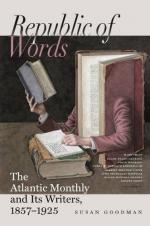Thus varied and benignant are the aspects of winter on these sunny days. But it is impossible to claim this weather as the only type of our winter climate. There occasionally come days which, though perfectly still and serene, suggest more terror than any tempest,—terrible, clear, glaring days of pitiless cold,—when the sun seems powerless or only a brighter moon, when the windows remain ground-glass at high noontide, and when, on going out of doors, one is dazzled by the brightness and fancies for a moment that it cannot be so cold as has been reported, but presently discovers that the severity is only more deadly for being so still. Exercise on such days seems to produce no warmth; one’s limbs appear ready to break on any sudden motion, like icy boughs. Stage-drivers and dray-men are transformed to mere human buffaloes by their fur coats; the patient oxen are frost-covered; the horse that goes racing by waves a wreath of steam from his tossing head. On such days life becomes a battle to all householders, the ordinary apparatus for defence is insufficient, and the price of caloric is continual vigilance. In innumerable armies the frost besieges the portal, creeps in beneath it and above it, and on every latch and key-handle lodges an advanced guard of white rime. Leave the door ajar never so slightly and a chill creeps in cat-like; we are conscious by the warmest fireside of the near vicinity of cold, its fingers are feeling after us, and even if they do not clutch us, we know that they are there. The sensations of such days almost make us associate their clearness and whiteness with something malignant and evil. Charles Lamb asserts of snow, “It glares too much for an innocent color, methinks.” Why does popular mythology associate the infernal regions with a high temperature instead of a low one? El Aishi, the Arab writer, says of the bleak wind of the Desert, (so writes Richardson, the African traveller,) “The north wind blows with an intensity equalling the cold of hell; language fails me to describe its rigorous temperature.” Some have thought that there is a similar allusion in the phrase, “weeping and gnashing of teeth,”—the teeth chattering from frost. Milton also enumerates cold as one of the torments of the lost:—
“O’er many a frozen, many a fiery Alp”;
and one may sup full of horrors on the exceedingly cold collation provided for the next world by the Norse Edda.
But, after all, there are few such terrific periods in our Massachusetts winters, and the appointed exit from their frigidity is usually through a snow-storm. After a day of this severe sunshine there comes commonly a darker day of cloud, still hard and forbidding, though milder in promise, with a sky of lead, deepening near the horizon into darker films of iron. Then, while all the nerves of the universe seem rigid and tense, the first reluctant flake steals slowly down, like a tear. In a few hours the whole atmosphere begins to relax once more, and in our astonishing climate very possibly the snow changes to rain in twenty-four hours, and a thaw sets in. It is not strange, therefore, that snow, which to Southern races is typical of cold and terror, brings associations of warmth and shelter to the children of the North.




